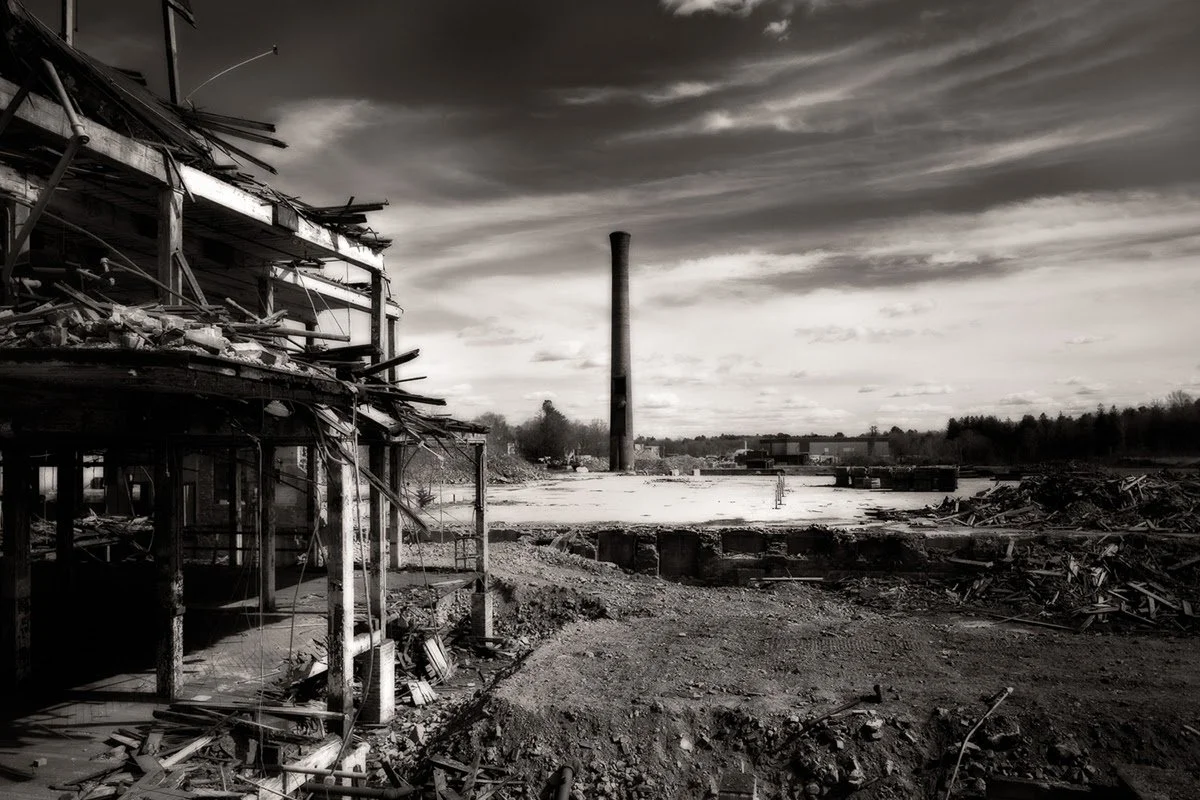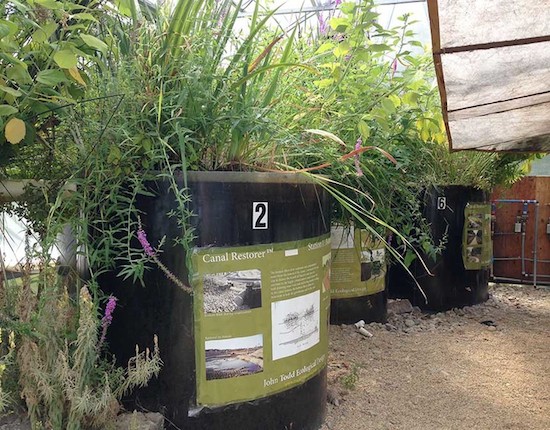A looming void
An image from James Hunt’s show “The Draper Factory Demolition,’’ at the RI Center for Photographic Arts, Providence, through Feb. 11.
The Draper factory, in Hopedale, Mass., was once the world’s largest manufacturer of powered cotton looms, with the machines built there playing a role in the American Industrial Revolution. The demolition of the 80-acre complex, in 2020, came after it had stood vacant since 1980, creating a void in the fabric of Hopedale.
A utopian Christian community (there were a lot of them in the mid-19th Century) was established in 1842 in Hopedale. It went bankrupt in 1856, and its assets were purchased by Ebenezer and George Draper, manufacturers of looms.
Cleaning up the Blackstone River naturally
Living Systems Laboratory built in 2013 for progress and profits cleans 10,000 gallons of river water daily.
BY CATHERINE SENGEL, for ecoRI News
SOUTH GRAFTON, Mass.
The heads of a few dozen turtles bob up from the waters surrounding a floating island along a verdant stretch of the Blackstone River. Five years ago, this expanse beside the Blackstone Canal and below the Fisherville Pond Dam was a dead zone, devoid of aquatic life.
But thanks to an experimental Living Systems Laboratory built in 2013 on the former site of the historic Fisherville Mill, 10,000 gallons of water are cleaned daily of the contaminants that once choked all living matter. By reintroducing the biological diversity once part of the ecosystem, the operation is restoring vitality to the river at a pace a thousand times faster than nature.
In addition, owner and developer Gene Bernat hopes it will offer an unparalleled education on our relationship with our environment.
“All of the different biological kingdoms that we employ here provide natural solutions to more than 200 years of incremental problems,” Bernat said during a recent tour of this lab. “It’s a visual roadmap of how we get from an extractive economy to a sustainable economy, and the premier experience in ecological literacy that you can find in the Northeast.”
Part of a string of mill villages in the valleys below the river’s headwaters in Worcester, Fisherville was home to one of the largest mills on the Blackstone River, supplying wool to the world from the early 1700s. In the mid-19th Century, a network of 48 granite locks and steps channeled flow along the Blackstone Canal, allowing the visionaries of America’s Industrial Revolution to power their mills and move goods in and out between Worcester and Providence.
Over the centuries, the river went from supplying food and canoe transport between communities for Native Americans and early settlers to providing energy for manufacturing and finally a convenient disposal place for waste.
In 1999, the 300,000-square-foot Fisherville Mill burned, sending deposits of asbestos to coat yards as far away as Hopedale and adding to an already toxic legacy. When talk turned to cleaning up the remaining pile of mill rubble after eight years, Bernat’s Fisherville Redevelopment Co. teamed with the town of Grafton to apply lessons learned elsewhere about resource restoration combined with an economic incentive.
The land would be cleared for Mill Villages Park, a development of 240 residential units with 60,000 square feet of commercial space. Site remediation was just finishing when the market collapse put a halt to building, but work on the Living Systems Laboratory moved forward.
Bernat, from three generations of textile makers, grew up dividing his summers between work in the Bernat yarn mill in Uxbridge and the woods of the family farm in Grafton. His time in forestry had sparked an interest in natural systems and resource management. To his reasoning, there was no question that the property would be a long-term durable asset for the Blackstone Valley and the community, with or without housing and shops.
Situated within the Blackstone River Valley National Heritage Corridor, the Fisherville Mill site is on one of largest existing water areas on the Blackstone Canal, with remnants of historic locks, a 200-foot-wide step dam and a continuous perennial waterfall from days of industrial development. Fisherville Pond is one of the last mill ponds on the river, and a premier migratory waterfowl nesting site.
In addition to large expanses of mostly untouched floodplain, the surrounding area includes still-intact mill villages, including mill housing. Two other yarn mills within a quarter mile, in Saundersville and Farnumsville, put Mill Villages Park and Pavilion at their center.
Rather than dwell on impediments to park progress, Bernat began to consider the entire area as a living, teaching landscape.
A consortium of area universities, including Brown, Clark, Tufts and Worcester Polytechnical Institute, along with the Blackstone Headwaters Coalition, Blackstone Heritage Corridor Coalition and Mass Audubon, joined Bernat to launch the Living Systems Laboratory. John Todd Ecological Design (JTED), a global pioneer in the use of natural systems to remove contaminants from water, was enlisted to help customize operations to the challenge at hand.
On the premise that one organism’s waste is another organism’s food source, JTED used a combination of tanks and aquatic cells in its bioremediation to mimic natural processes.
Bins of wood pellets and water support the growth of fungi that consume petroleum hydrocarbons.
In a temporary, riverside greenhouse, water from the Blackstone is pumped through a series of bins. Filled with wood pellets and water, they support growth of a variety of fungi that consume oil residues.
From there, the water moves through a progression of six tanks, or “aquatic cells,” where native plants, shrubs and trees hang on fiberglass racks, roots reaching down to support worlds of algae, zooplankton and other microorganism which in turn nourish snails, clams and fish.
“By introducing the contaminants, we’re telling nature to try and use them,” Bernat said.
The older the system, the more mature and diverse the biology, the better it is at treating waste products, according to Bernat. Species purposely excluded in construction of the ecological incubator introduced themselves into bins and tanks, he noted, proving that every species has a purpose in nature.
The concept is new and radical and has enormous potential. The first year of operation saw a more than 95 percent drop in petroleum hydrocarbons in water samples from input to outflow back into the river. Water clean enough to drink is now packed with beneficial organisms and life forms that digest oils, dyes and contaminants, and returned to the Blackstone River.
Canal restorers made of bamboo and local vegetation float on the Blackstone, supporting ecosystems once abundant in the river.
Taken together, bins and tanks create a circulating loop — a stream within the stream in which water is purified at a rate of 10,000 gallons a day and the canal is re-seeded with healthy ecology. In the river, constructed bamboo “canal restorers” — some surrounded by oil booms to collect slick — float upstream of an old granite bridge collecting and consuming additional pollutants.
“Everything that occurs in here in this greenhouse is happening in the natural world around us without our intervention,” Bernat said. “But with our intervention, we make it over a thousand times as effective in cleaning up contaminants as the natural world does itself.”
The site has already received both local and international attention for its community-designed Mill Villages Park and the chemical-free remediation. Beyond the value of an ecological wastewater treatment system, Bernat champions the educational potential of the operation.
From the obvious to the microscopic, there are centuries of historical, cultural and biological lessons on the past, present and future for levels from preschool to Ph.D.
Students from Worcester Tech are duplicating the process in a greenhouse they built at their high school to study bioremediation. Senior fellows, researchers and policymakers from the University of Rhode Island Coastal Institute visited to learn about the system’s EcoMachine™ design.
In December 2014, the town was awarded a $10,000 grant by the Blackstone River Valley National Heritage Corridor for the Fisherville Mill Redevelopment site. The money will be used to create a teaching landscape, build a more permanent greenhouse, and develop educational materials and programs focused on the ecology and industrial history of the Blackstone River Valley.
Students from the Conway School of Landscape Design created a vision plan for the site that will, in time, include nature paths, a boat launch, an amphitheater, exhibit space and a model of cross-discipline education. Plants are being introduced into aquatic labs in the hope that flowers can be grown and sold commercially as an added economic component.
“What we learn here and teach here is applicable to the environment no matter where,” Bernat said. “Rather than a scholastic understanding of how things work, you should be able to walk through the site and really begin to grasp the miracles of nature and how we help that process or how we’ve damaged that process through our past activities.
“If you look at rivers almost without exception in the industrialized world, they really are the sewer system of our society.”
One of the many lessons the river offers is that there is no such thing as “away” when it comes to waste. Whether buried in a landfill or dumped in a river to be carried out to Narragansett Bay and beyond, that garbage still exists along with its long-term consequences.
“There’s an intimate dynamic between humanity and our environment ... we are all canaries in a coal mine,” Bernat said. “We see animals dying and habitat being destroyed and we just think it’s the price of progress.”
The Living Systems Laboratory is a vision for progress and profits without environmental cost, according to Bernat. He’s excited to announce that frogs finally returned to the river this year.
“If we’re going to survive, we have to start looking at water in a completely different way,” he said. “The park vastly improved South Grafton, and now we have the potential to do so much more.”


